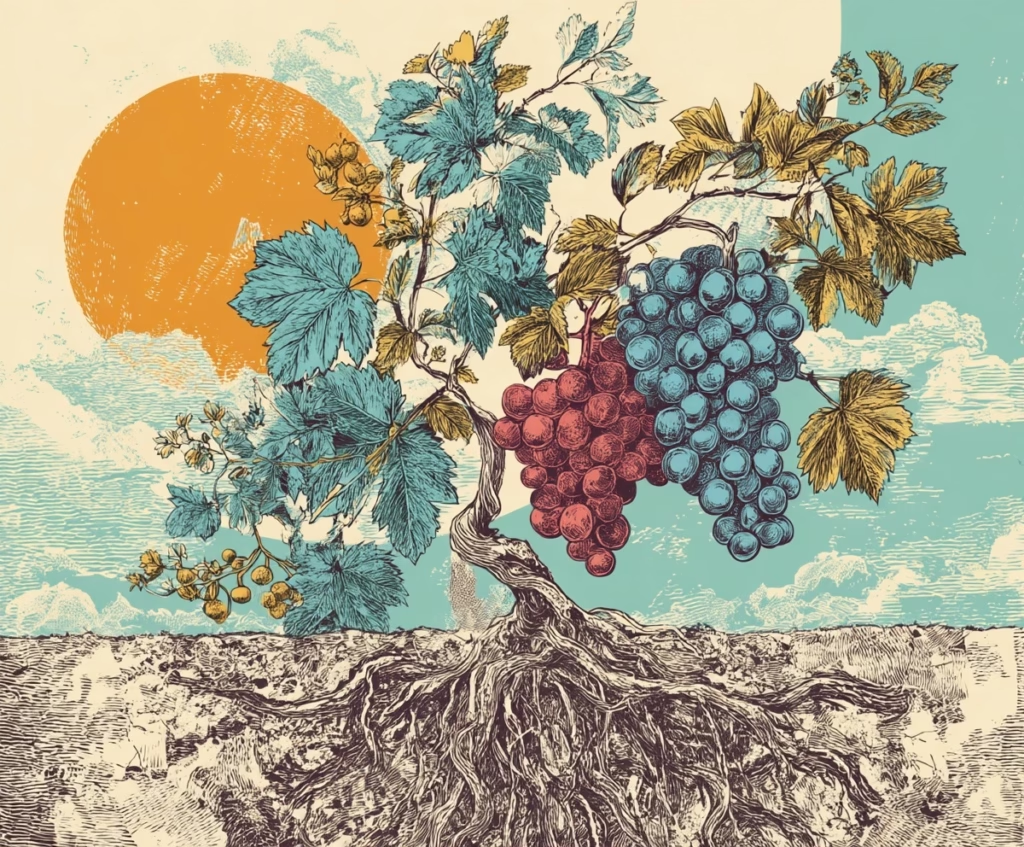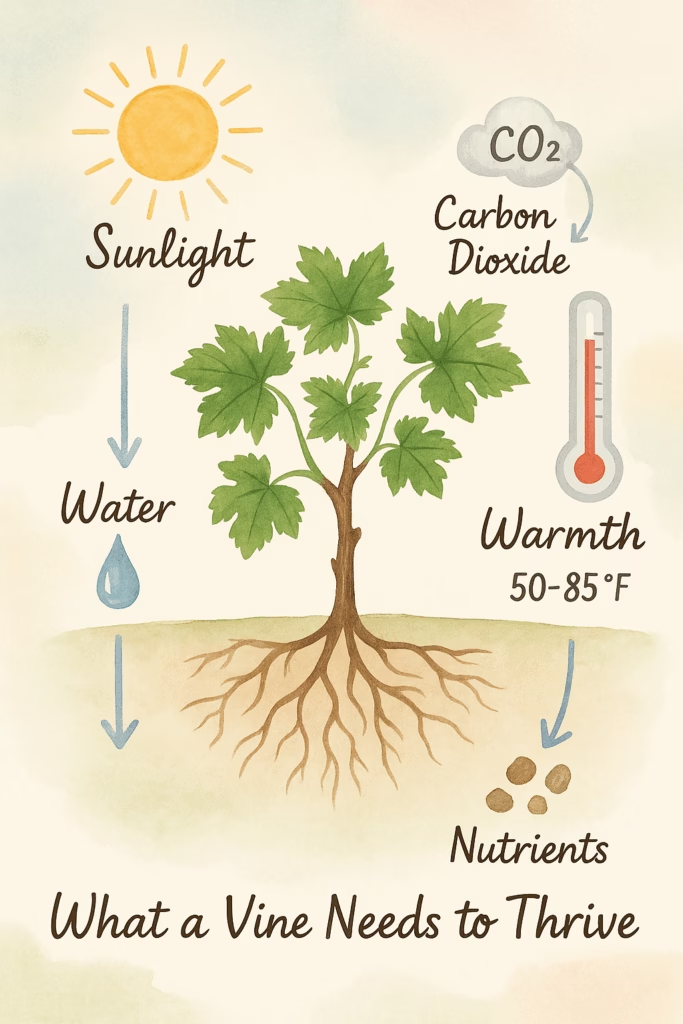What a Vine Wants: The 5 Essential Ingredients for Growing Great Grapes
And a grapevine thrives on a perfectly calibrated cocktail of elements: warmth, sunlight, water, nutrients, and carbon dioxide.

Before barrel, the bottle, the bar, and the glass—there’s the vine. And a grapevine doesn’t thrive on vibes alone. It needs a perfectly calibrated cocktail of elements: warmth, sunlight, water, nutrients, and carbon dioxide. (Yes, carbon dioxide—not monoxide. One helps it breathe; the other, not so much. Think spa day, not smog alert.)
In our post on the grapevine lifecycle, we walked through the stages from dormancy to budburst to harbest—a full-on glow-up that unfolds over the seasons with each vintage. But today, we’re going deeper into the environmental factors that make that journey possible. Because a vine’s needs aren’t random. They’re rhythmic. Elemental. Seasonal. And just like a good Taurus, vines know that growth takes a mix of grounding and glow.
So what exactly does a vine need to thrive? Let’s break it down.
🌡 Warmth: The Growing Season’s Goldilocks Zone
Vines are picky about temperature. Too cold, and nothing wakes up in spring. Too hot, and the sugars spike before the grapes develop full flavor. Most wine grapes like a growing season that hovers between 50°F and 85°F (with exact needs varying based on the stage of the grape lifecycle).
Warmth determines when the vine wakes from winter dormancy, how quickly it moves through flowering and fruit set, and how fully grapes ripen. Cooler climates (think Champagne or Mosel) give you lean, racy wines with high acidity. Warmer regions (like Napa or Barossa) yield riper, bolder styles.
It’s not just heat—it’s timing. A sunny September is great. A freak frost in May? Devastating. The vine’s rhythm is synced to the soil’s thermostat.

🌗 Fun Fact: Why Diurnal Range Matters for Wine: You know how your skin glows after a sunny day followed by a crisp evening? Grapes feel the same. Diurnal range—the difference between daytime highs and nighttime lows—is a secret weapon in vineyard magic. Warm days help the vine produce sugars through photosynthesis, giving grapes ripeness and body. Cool nights, on the other hand, slow things down—locking in acidity and preserving aromatic freshness. Regions with big day-night swings (like Mendoza in Argentina or California’s Santa Rita Hills) often produce wines that hit that perfect sweet spot: lush but lifted, ripe yet refreshing. It’s like nature’s way of giving grapes both a sunbath and a cold plunge.
☀️ Sunlight: The Grape’s Solar Power Source
Sunlight is the ultimate sugar daddy. Through photosynthesis, vines turn sunlight into glucose—the building block of grape sugar, which later becomes alcohol during fermentation.
More sunlight = more sugar = riper grapes. But more isn’t always better. In overly sunny climates, grapes can over-ripen, losing freshness and aromatic nuance. On the other hand, in shaded or cloudy zones, ripening may stall, leaving you with underripe, vegetal notes.
Balance is key, and is achieved with good vineyard management to help balance out whatever a grapevine’s location provides. Growers balance leaf cover to protect bunches from sunburn while ensuring the vine still soaks up enough rays to do its thing.
💧 Water: Thirsty but Thriving
Yes, vines need water. But not too much. In fact, great wine grapes often grow better under a little stress—like a Byronic hero brooding through drought and gravel.
Water fuels photosynthesis, keeps leaves perky, and helps grapes grow in size during verasion. But excess water (from over-irrigation or heavy rainfall) can lead to bloated berries with dilute flavors and promote disease. That’s why dry-farming (no irrigation) is prized in places like California or the Douro—if the vine can survive without help, the fruit is often more concentrated.
The trick? Keep the vine just thirsty enough to dig deep, develop resilience, and focus its energy on fewer, more flavorful grapes. Like any good character arc, the struggle makes it interesting.
🪨 Nutrients: Soil With Soul
A vine doesn’t want a buffet—it wants a tasting menu (with pairings, please). Grape vines thrive in soils that are low in fertility but rich in personality: limestone for minerality, volcanic soils for intensity, clay for power, granite for perfume.
The soil provides nitrogen (for leafy growth), potassium (for sugar transport), phosphorus (for root health), and micronutrients like magnesium, calcium, and iron. But it’s not just what’s in the soil—it’s how well it drains, warms, and holds water.
Think of soil as the spices in a recipe. It doesn’t just feed the vine—it shapes the wine’s structure, flavor, and energy. A vine with just enough to eat and a lot to say? That’s where the magic happens.
🌬 Carbon Dioxide: The Unsung Hero of Every Glass
Last but not least: carbon dioxide, CO₂, is the gas vines inhale during photosynthesis. Combine CO₂ with sunlight and water, and you get glucose (aka grape sugar) and oxygen. It’s the equation at the heart of every vineyard.
In short: no CO₂ → no sugar → no fermentation → no wine. And we can’t have that.
Interestingly, rising CO₂ levels from climate change can increase vine productivity—but it’s a double-edged sword. More sugar can mean higher alcohol, throwing off balance. Once again, it’s all about calibration.
From Needs to Nectar
Every sip of wine is a reflection of how these five forces came together over the course of a growing season. Did the summer stay mild? Was water rationed just right? Did the roots dig deep for minerals? Did the leaves soak up the sun? Was the vine stressed (but not broken)?
So the next time you swirl your glass, give a quiet cheers to the unsung work of warmth, sun, water, soil, and CO₂. They’re the real MVPs behind every bottle.


